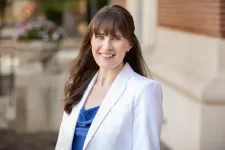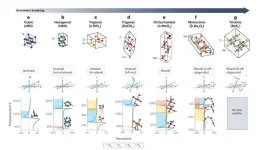(Press-News.org) CHAMPAIGN, Ill. — By one estimate, as many as 30% of people in the U.S. are in romantic relationships with partners who do not share their political views. In today’s hyperpartisan climate, where Democrats and Republicans have difficulty talking to each other and their views are polarized about media outlets’ credibility, how do couples with differing political perspectives decide which media to follow? And how do these decisions affect their discussions on political issues and their relationship in general?
To explore these questions, University of Illinois Urbana-Champaign communication professor Emily Van Duyn conducted in-depth interviews with 67 people whose partners’ political views differed from their own. For these couples, seemingly mundane decisions about media consumption became “especially difficult,” Van Duyn said.
“Their cross-cutting political views presented many challenges for these couples,” Van Duyn said. “Deciding which media to consume and whether to do so together or separately was difficult because it presented them with a choice about recognizing their political differences and finding a way to navigate them.
“They saw the news as inherently political, and their selection of a news outlet or the act of sharing an article or video meant they were intentionally pulling their partner into a recognition of their political differences.”
News coverage activated differences between the partners that otherwise would not have emerged, sparking conflict as well as discussion. Conflict emerged in various ways, including disagreement over news sources and content, but also when one person failed to respond as intensely as their partner when the latter shared news that they found disturbing or alarming, Van Duyn said.
Partners’ differing political beliefs and/or identities created a need to influence or negotiate their news consumption, a process that Van Duyn calls “negotiated exposure” and that played out across public-facing media such as television and those that are more private in nature like social media.
This process and the interpersonal conflict that resulted from it “often worked in tandem to reinforce one another and impact the relationship,” Van Duyn said. “Conflict resulting from news consumption often caused individuals to seek greater control of their news exposure, a reinforcing process that highlights the muddled order in how individuals simultaneously navigate news and relationships in contemporary democracy.”
Van Duyn chose to interview only one partner from each couple so that participants would feel comfortable speaking freely without the concern of impacting their relationship or feeling constrained by their partners’ views. To protect the privacy of those interviewed, who were recruited through social media advertisements, pseudonyms were used in the study.
Of the participants, 39 were female, 27 were male and one identified as non-binary. Most were in opposite-sex relationships and had been in their current relationship more than two years. The majority (42) of the study participants where white, 11 were Black, three were Hispanic and 11 were Asian.
A 46-year-old Virginia woman identified as “Wendy” in the study was a Donald Trump-supporting Republican whose boyfriend of two years was a Democrat who voted for Hillary Clinton. Wendy said that she and her partner compromised on which news programs they viewed on television and when, with Wendy having control over programming during the morning hours and her boyfriend’s preferences taking precedence during the afternoon.
Since the couple fervently disagreed about then-President Trump, co-viewing TV news together created friction, especially when Wendy felt there was too much negative coverage of Trump and wanted to avoid it. Moreover, negative news stories about Trump made Wendy susceptible not only to her boyfriend’s criticism of her favored candidate – but also of herself, personally.
Some couples sought a common media outlet they could agree on to co-view together, while others intentionally chose to consume news independently, whether in separate rooms or by scrolling their social media feeds on separate devices while in each other’s company. Other individuals sought ways of consuming news with their partner that superseded their differences and utilized other news media privately, according to the study.
Nancy, a 49-year-old Michigan woman who had switched from voting Republican to voting Democratic in 2016 and 2020, said her husband was a Trump supporter that held political beliefs she described as “diametrically opposed” to her own. News was a significant source of conflict between them as was Nancy’s ideological shift, which her husband attributed to her viewing CNN.
Nancy, who worked from home, responded by watching CNN secretly during the day when her spouse was away and kept her political activity – working as a text banker for the Democratic party during the 2020 election – secret as well.
“The point in their relationship when couples’ political differences emerged affected how partners negotiated news with one another,” Van Duyn said. “While some were aware of their ideological differences at the outset of the relationship, other individuals found their shared tradition of amicably co-viewing the news together disrupted when their partners’ views or party affiliation changed. Negotiations around news selection in cross-cutting relationships involved a negotiation of political identity as much as of news exposure.”
When the news began to take a negative toll on some participants and their relationship, these couples decided to avoid the news altogether and quit sharing articles or videos with each other because doing so triggered tensions that affected their emotional intimacy.
Van Duyn said that some of those who chose news avoidance cited heightened conflict within their relationship or mental health concerns such as anxiety.
The study, published in the journal Political Communication, was funded by the Institute for Humane Studies at George Mason University.
END
News media trigger conflict for romantic couples with differing political views
2024-01-12
ELSE PRESS RELEASES FROM THIS DATE:
Earth-sized planet discovered in ‘our solar backyard’
2024-01-12
MADISON — A team of astronomers have discovered a planet closer and younger than any other Earth-sized world yet identified. It’s a remarkably hot world whose proximity to our own planet and to a star like our sun mark it as a unique opportunity to study how planets evolve.
The new planet was described in a new study published this week by The Astronomical Journal. Melinda Soares-Furtado, a NASA Hubble Fellow at the University of Wisconsin–Madison who will begin work as an astronomy professor at the university in the fall, and recent UW–Madison graduate Benjamin Capistrant, now a graduate student at the University of Florida, co-led the study with co-authors from ...
NASA analysis confirms 2023 as warmest year on record
2024-01-12
Earth’s average surface temperature in 2023 was the warmest on record, according to an analysis by NASA. Global temperatures last year were around 2.1 degrees Fahrenheit (1.2 degrees Celsius) above the average for NASA’s baseline period (1951-1980), scientists from NASA’s Goddard Institute for Space Studies (GISS) in New York reported.
“NASA and NOAA’s global temperature report confirms what billions of people around the world experienced last year; we are facing a climate ...
Incontinence could point to future disability
2024-01-12
If you are one of the 30% to 50% of women experiencing urinary incontinence, new research suggests that it could turn into a bigger health issue.
Having more frequent urinary incontinence and leakage amounts is associated with higher odds of disability, according to RUSH researchers in a study published in the January issue of Menopause.
“Often symptoms from urinary incontinence are ignored until they become bothersome or limit physical or social activities,” said Sheila Dugan, MD, chair of the Department of Physical Medicine and Rehabilitation at RUSH. “Because this study suggests that urinary incontinence is associated with disability, ...
Core-shell ‘chemical looping’ boosts efficiency of greener approach to ethylene production
2024-01-12
Ethylene is sometimes called the most important chemical in the petrochemical industry because it serves as the feedstock for a huge range of everyday products. It’s used in the production of antifreeze, vinyl, synthetic rubber, foam insulation, and plastics of all kinds.
Currently, ethylene is produced through an energy- and resource-intensive process called steam cracking, where extremes of temperature and pressure produce ethylene from crude oil in the presence of steam—and in the process, emit tons of carbon dioxide into the atmosphere. Another way ...
Targeting Microbiota 2024: Shaping the future of medicine – International leaders unite at the 11th World Congress
2024-01-12
The International Society of Microbiota (ISM) is pleased to announce its 11th World Congress, Targeting Microbiota 2024. This congress is scheduled to take place on October 17-18 in Malta, and will convene international leading experts, researchers, and professionals to explore and discuss the latest advancements in the field of microbiota. Under the new presidency of Maria Cecilia Giron, University of Padova, we anticipate a transformative era, propelling the ISM to new heights in microbiota research.
Thorough Investigation through Specialized Tracks
Recent Advances & Challenges in Microbiota
Microbiota-Host Cross-Talk and Signaling
Metabolomics: Innovations ...
How should boards handle visionary CEOs?
2024-01-12
AUSTIN, Texas — The recent firing and rapid rehiring of Sam Altman, the co-founder and CEO of ChatGPT creator OpenAI, illustrates the delicate dance between visionary CEOs and the boards who oversee them.
Some CEOs — often founders — are fueled by strong convictions about the strategic direction their companies should take. But their boards sometimes don’t share their visions.
When that happens, what is the board’s role in governance? Should it monitor or advise the CEO? Should it back off and approve the CEO’s strategy?
The answer depends on how deeply the CEO is invested in the strategy, says Volker Laux, professor of accounting at Texas ...
Drinkable, carbon monoxide-infused foam enhances effectiveness of experimental cancer therapy
2024-01-12
Did smokers do better than non-smokers in a clinical trial for an experimental cancer treatment? That was the intriguing question that led University of Iowa researchers and their colleagues to develop a drinkable, carbon monoxide-infused foam that boosted the effectiveness of the therapy, known as autophagy inhibition, in mice and human cells. The findings were recently published in the journal Advanced Science.
Looking for ways to exploit biological differences between cancer cells and healthy cells ...
Light-matter interaction: broken symmetry drives polaritons
2024-01-12
An international team of scientists provide an overview of the latest research on light-matter interactions. A team of scientists from the Fritz Haber Institute, the City University of New York and the Universidad de Oviedo has published a comprehensive review article in the scientific journal Nature Reviews Materials. In this article, they provide an overview of the latest research on polaritons, tiny particles that arise when light and material interact in a special way.
In recent years, researchers worldwide have discovered that there are different types of polaritons. Some of them can trap light in a very small space, about the size of a nanometer. That's ...
Neuroscientists identify 'chemical imprint of desire'
2024-01-12
Hop in the car to meet your lover for dinner and a flood of dopamine— the same hormone underlying cravings for sugar, nicotine and cocaine — likely infuses your brain’s reward center, motivating you to brave the traffic to keep that unique bond alive. But if that dinner is with a mere work acquaintance, that flood might look more like a trickle, suggests new research by University of Colorado Boulder neuroscientists.
“What we have found, essentially, is a biological signature of desire that helps us explain why we want to be with some people more than other people,” said senior author Zoe Donaldson, associate professor ...
Trends in cancer mortality disparities between Black and white individuals in the US
2024-01-12
About The Study: Although U.S. age-adjusted cancer mortality rates declined significantly between 2000 and 2020, substantial racial and ethnic disparities persisted for many common and preventable cancers, including female breast and male colorectal cancer. Cancer disparities arise from a confluence of factors, including structural racism, medical mistrust, health care access inequities, poor socioenvironmental conditions, aggressive tumor biology, and genetic ancestry.
Authors: Tomi Akinyemiju, Ph.D., M.S., of the Duke University School of Medicine in Durham, North Carolina, is the corresponding author.
To access the embargoed study: Visit our For The Media website ...







